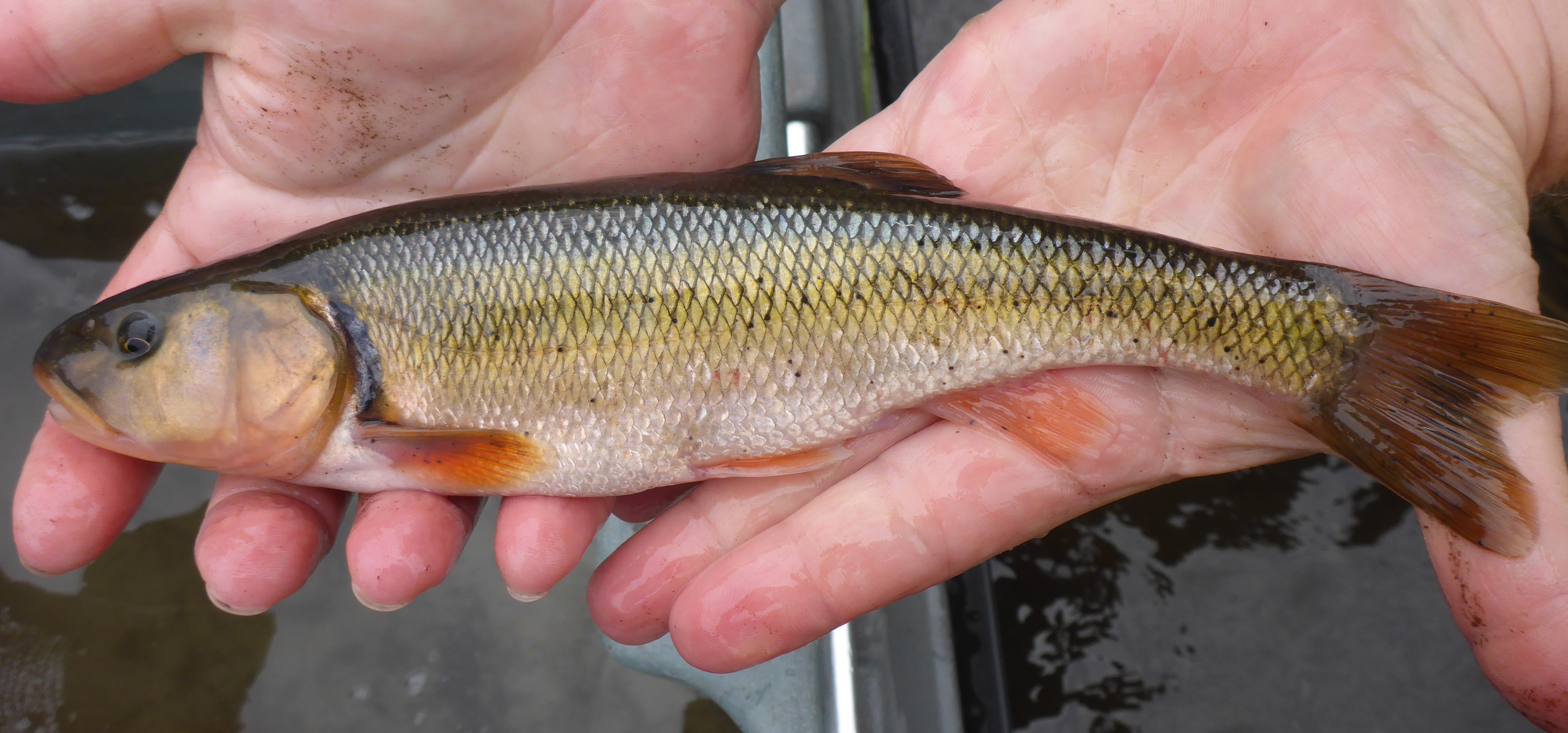Fish Iowa - Fish Species - Creek Chub

Characteristics
Body form is stout and robust, with a broad, blunt head. There is a black spot in the first 3 rays of the dorsal fin. It has a very large mouth. A small, flap-like barbel is located in the groove in the middle of the upper jaw. A wedged-shaped spot appears at the base of the tail. Body color of the back and sides varies from olive to purplish changing to silvery-white on the belly, and a lateral stripe runs from the tip of the snout through the eye to the end of the caudal peduncle. The intensity of the lateral stripe and dorsal color depends on water clarity, darker individuals come from clearer waters. Creek Chubs look striped because of the dark color above, light streak just above the dark lateral line, and then white beneath. The dorsal fin is behind the base of the pelvic fins, and the anal fins have 8 rays, while the pectoral fins have 16 or 17, and the pelvic fins have 8 rays. Body scales are very small and look cross-hatched on the upper back and sides. Lateral line scales range from 49 to 64, and are sometimes interrupted by missing pores. A terminal, slightly oblique mouth extends to below the eye and usually has a barbel; the barbel may be absent from one or both sides. Hooked pharyngeal teeth, on stout arches, are arranged in two rows and have the formula 2, 5-4, 2. Breeding males develop a rosy tint on the body and form large nuptial tubercles on the head and snout. Fins may become light yellowish to light olive in color.
Foods
aquatic and terrestrial insects, insect larvae, crustaceans, mollusks and small fish
Expert Tip
For a great adventure close to home, go fishing at a small stream with a little spinner (Mepps size 0, for example). For even more fun, try fly fishing with small wet (sinking) flies. Keep a few to use as live bait the next time you go fishing for bigger fish, or to use as cut bait for catfish.
Details
Creek Chubs live in small to medium-sized streams with silt-free gravel bars. They frequent streams with alternate riffles and pools rather than continuous strong flow, living where there are plenty of holes, brush, roots, or other cover for retreat if threatened. They can endure turbidity, if the current sweeps the gravel free of silt. Creek Chubs are one of the largest and most dominant fish in Iowa creeks and streams.
Male Creek Chubs prepare a nest in the gravel-bottomed run by mounding up gravel about 3 inches high and several feet long using their snout and mouth. Spawning starts in May when the water temperature reaches about 65 degrees. Eggs are deposited in the nest by one or more females over two weeks and covered with gravel by the male as nest building continues. The male guards the nest against intruders with tubercle displays or swimming in a ritualized combative posture.
Creek Chubs reach about 12-inches long after 4 years of life.
Creek Chubs provide some angling in small streams, particularly for young fishermen, and are an excellent food-fish. They are one of the main baitfish because they are hardy, abundant and easily kept in confinement. In the wild, they are an important forage fish for sport fish species.
Recent stream sampling information is available from Iowa DNR's biological monitoring and assessment program.
Sources:
Harlan, J.R., E.B. Speaker, and J. Mayhew. 1987. Iowa fish and fishing. Iowa Conservation Commission, Des Moines, Iowa. 323pp.
Loan-Wilsey, A. K., C. L. Pierce, K. L. Kane, P. D. Brown and R. L. McNeely. 2005. The Iowa Aquatic Gap Analysis Project Final Report. Iowa Cooperative Fish and Wildlife Research Unit, Iowa State University, Ames
Illustration by Maynard Reece, from Iowa Fish and Fishing
Distribution Map

Widely distributed in all major drainage basins in Iowa, but its abundance in fish collections varies with location. It is common in most of our small streams, while it is rare to occasional in the large interior rivers. It is rare in the Great Border Rivers and seldom maintains populations in lakes and reservoirs.
See our most recent distribution data for this species on the Iowa DNR's Bionet application.
State Record(s)
No state record exists for this species
Submit your potential recordMaster Angler Catches
No Master Angler catches currently exist for this species.
Submit your Master Angler catchFish Surveys
Tip: Click Species Length by Site, then use the dropdown to filter by fish species of interest.Where this Fish Is Found
Baileys Ford
Bass Creek
Bigalk Creek
Bloody Run Creek
Bohemian Creek
Brush Creek
Brush Creek
Buck Creek
Coldwater Creek
Coon Creek
East Nishnabotna River
East Nodaway River
East Pine Creek
Fountain Springs
Hewett and Ensign Creeks (Ensign Hollow)
Joy Springs
Little Sioux River (Correctionville to Missouri R)
Little Sioux River (Linn Grove to Correctionville)
Little Sioux River (state line to Linn Grove)
Little Turkey River
Maquoketa River (trout portion)
McLoud Run
Mink Creek
Missouri River (Council Bluffs to state line)
Missouri River (Little Sioux to Council Bluffs)
Missouri River (Sioux City to Little Sioux)
Monastery Creek
Mossy Glen
North Cedar Creek
Otter Creek
Paint Creek
Ram Hollow
Richmond Springs
Sny Magill Creek
Spring Branch
Spring Creek
Swiss Valley Creek
Tete des Morts River
tributaries to Tete des Morts River
Trout River
Trout Run
Turtle Creek
Twin Bridges
Wapsi River (Trout Section)
Wapsipinicon River (state line to Tripoli)
West Fork Grand River
West Nishnabotna River
Yellow River (Trout Section)